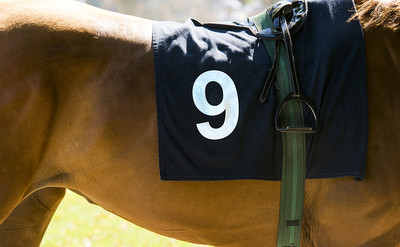 The Grand National is arguably the most thrilling race on the British jump racing calendar. Whilst racing purists will always talk of the Cheltenham Gold Cup as being the best, the National is the event that grips the public imagination. It is a race that even those that don’t like to bet on horse racing will often have a wager on, with workplaces and friends up and down the country doing a sweepstake for it every year.
The Grand National is arguably the most thrilling race on the British jump racing calendar. Whilst racing purists will always talk of the Cheltenham Gold Cup as being the best, the National is the event that grips the public imagination. It is a race that even those that don’t like to bet on horse racing will often have a wager on, with workplaces and friends up and down the country doing a sweepstake for it every year.
Because it is the kind of race that everyone likes to have a flutter on, those that don’t normally care about horse racing suddenly want to read the tea leaves to see if there’s any information that they should consider when coming to place their bet. Is it as simple as just picking the favourite? Should you look into a horse’s form? Or is it as simple as just looking to see what their name is and if you like it? Here we’ll look at whether age is a factor you should consider.
What Is the Average Age of Grand National Winners?
The average age of Grand National winning horses between 1946 and 2023 is 9.6 years old. Nine year old horses have won 35.5% of races in this time, with eight year olds the second most frequent, winning 19.7% of Grand Nationals run since the Second World War.
During this period, there has only been one seven-year-old winner, Noble Yeats in 2022. The last seven-year old to win prior to Noble Yeats was Bogskar in 1940.
Grand National Age Restrictions
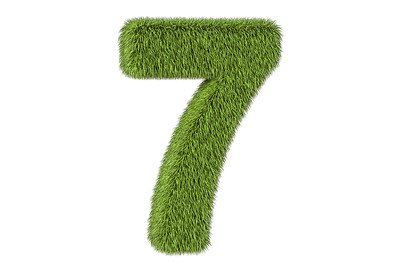 All horse races have age restrictions in place, whether it be because they’re aimed at younger horses or because the course is so testing as to mean that inexperienced horses will struggle with it. The Grand National very much fits into the latter category, based as it is over four miles and 514 yards and featuring 30 fences that the competitors will need to get over if they hope to have a chance of winning the race.
All horse races have age restrictions in place, whether it be because they’re aimed at younger horses or because the course is so testing as to mean that inexperienced horses will struggle with it. The Grand National very much fits into the latter category, based as it is over four miles and 514 yards and featuring 30 fences that the competitors will need to get over if they hope to have a chance of winning the race.
The event’s length means that participating horses will need to have a good degree of stamina, which is the sort of thing that is built up over many years of racing and doesn’t typically tend to just be something that a horse is born with. The fences on the Grand National course, meanwhile, are much larger than the sort of fences that most National Hunt events have, meaning the horse needs to be large and strong enough to jump them.
So it is that horses that owners and trainers wish to run in the National need to be aged seven or older. Not only that, but they also need to meet certain other criteria in order to take part in the race. As well as being seven or over, the horse also needs to be rated 120 or higher by the British Horseracing Authority and have previously finished within the places in a steeplechase that was run over three miles or more.
Why Age Matters
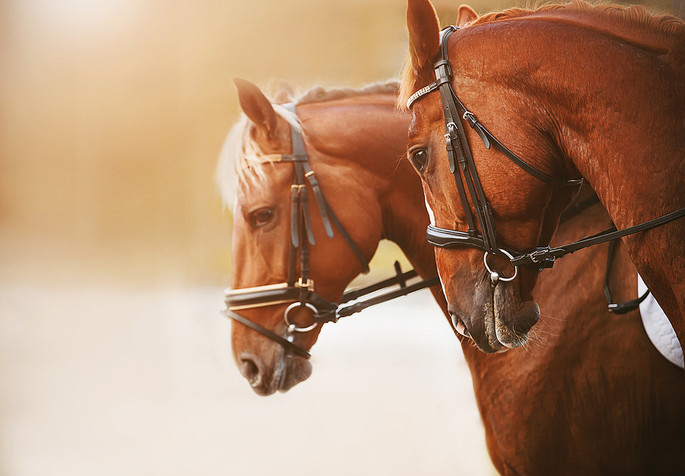
There are two main reasons why an age limit would be added to a race, with the first being that it gives younger horses a chance in the races that are aimed at them. If you have a hurdle race aimed at giving three-year-olds an experience of taking part in competitive races, for example, then you don’t want nine-year-old steeplechasers taking part and virtually guaranteeing themselves a win every single time.
Equally, there’s no point in a three-year-old hurdler being allowed to take part in a race that will largely be populated by chasers aged eight and over. By adding age restrictions or restriction on some other aspect of the race, such as them being for maiden horses, you limit the chances of the race being unfair to those taking part. The other reason, meanwhile, is for the safety of the horses that are running in the race.
Young, inexperienced horses will struggle with hurdling events, let along those that involve large and imposing fences. Never is that more true than with the Grand National, which is an event that features some of the most imposing fences in all of jump racing. A four or five-year-old horse with limited experience would struggle with a jump like The Chair, say, and so taking it on could cause them serious damage.
There’s also the possibility that an inexperienced and young horse would simply refuse to jump a particularly scary fence. That not only means that they’ll have failed in the race but also puts other horses running alongside them in danger. A famous example of this occurred in 1967 when a loose horse named Popham didn’t want to jump the 23rd fence, veering across it and causing a melee of other horses.
Ages of Grand National Winners
The best place to start when considering the sort of age that you might want to look at for your selections for the Grand National is by looking at previous winners of the race. We’ll look at the event from the post-Second World War onwards, essentially defining that as being the modern version of the race. Here’s a look at the winning horse, their age and the weight that they were asked to carry:
Grand National Winners, Ages & Weights – 1946 to 2023
| Year | Horse | Age | Weight Carried |
|---|---|---|---|
| 1946 | Lovely Cottage | 9 | 10 stone 8 pounds |
| 1947 | Caughoo | 8 | 10 stone |
| 1948 | Sheila’s Cottage | 9 | 10 stone 7 pounds |
| 1949 | Russian Hero | 9 | 10 stone 8 pounds |
| 1950 | Freebooter | 9 | 11 stone 11 pounds |
| 1951 | Nickel Coin | 9 | 10 stone 1 pound |
| 1952 | Teal | 10 | 10 stone 12 pounds |
| 1953 | Early Mist | 8 | 11 stone 2 pounds |
| 1954 | Royal Tan | 10 | 11 stone 7 pounds |
| 1955 | Quare Times | 9 | 11 stone |
| 1956 | E.S.B. | 10 | 11 stone 3 pounds |
| 1957 | Sundew | 11 | 11 stone 7 pounds |
| 1958 | Mr. What | 8 | 10 stone 6 pounds |
| 1959 | Oxo | 8 | 10 stone 13 pounds |
| 1960 | Merryman | 9 | 10 stone 12 pounds |
| 1961 | Nicolaus Silver | 9 | 10 stone 1 pound |
| 1962 | Kilmore | 12 | 10 stone 4 pounds |
| 1963 | Ayala | 9 | 10 stone |
| 1964 | Team Spirit | 12 | 10 stone 3 pounds |
| 1965 | Jay Trump | 8 | 11 stone 5 pounds |
| 1966 | Anglo | 8 | 10 stone |
| 1967 | Foinavon | 9 | 10 stone |
| 1968 | Red Alligator | 9 | 10 stone |
| 1969 | Highland Wedding | 12 | 10 stone 4 pounds |
| 1970 | Gay Trip | 8 | 11 stone 5 pounds |
| 1971 | Specify | 9 | 10 stone 13 pounds |
| 1972 | Well To Do | 9 | 10 stone 1 pound |
| 1973 | Red Rum | 8 | 10 stone 5 pounds |
| 1974 | Red Rum | 9 | 12 stone |
| 1975 | L’Escargot | 12 | 11 stone 3 pounds |
| 1976 | Rag Trade | 12 | 10 stone 12 pounds |
| 1977 | Red Rum | 12 | 11 stone 8 pounds |
| 1978 | Lucius | 9 | 10 stone 9 pounds |
| 1979 | Rubstic | 10 | 10 stone |
| 1980 | Ben Nevis | 12 | 10 stone 12 pounds |
| 1981 | Aldaniti | 11 | 10 stone 13 pounds |
| 1982 | Grittar | 9 | 11 stone 5 pounds |
| 1983 | Corbiere | 8 | 11 stone 4 pounds |
| 1984 | Hallo Dandy | 10 | 10 stone 2 pounds |
| 1985 | Last Suspect | 11 | 10 stone 5 pounds |
| 1986 | West Tip | 9 | 10 stone 11 pounds |
| 1987 | Maori Venture | 11 | 10 stone 13 pounds |
| 1988 | Rhyme ’N’ Reason | 9 | 11 stone |
| 1989 | Little Polveir | 12 | 10 stone 3 pounds |
| 1990 | Mr Frisk | 11 | 10 stone 6 pounds |
| 1991 | Seagram | 11 | 10 stone 6 pounds |
| 1992 | Party Politics | 8 | 10 stone 7 pounds |
| 1994 | Miinnehoma | 11 | 10 stone 8 pounds |
| 1995 | Royal Athlete | 12 | 10 stone 6 pounds |
| 1996 | Rough Quest | 10 | 10 stone 7 pounds |
| 1997 | Lord Gyllene | 9 | 10 stone |
| 1998 | Earth Summit | 10 | 10 stone 5 pounds |
| 1999 | Bobbyjo | 9 | 10 stone |
| 2000 | Papillon | 9 | 10 stone 12 pounds |
| 2001 | Red Marauder | 11 | 10 stone 11 pounds |
| 2002 | Bindaree | 8 | 10 stone 4 pounds |
| 2003 | Monty’s Pass | 10 | 10 stone 7 pounds |
| 2004 | Amberleigh House | 12 | 10 stone 10 pounds |
| 2005 | Hedgehunter | 9 | 11 stone 1 pound |
| 2006 | Numbersixvalverde | 10 | 10 stone 8 pounds |
| 2007 | Silver Birch | 10 | 10 stone 6 pounds |
| 2008 | Comply Or Die | 9 | 10 stone 9 pounds |
| 2009 | Mon Mome | 9 | 11 stone |
| 2010 | Don’t Push It | 10 | 11 stone 5 pounds |
| 2011 | Ballabriggs | 10 | 11 stone |
| 2012 | Neptune Collonges | 11 | 11 stone 6 pounds |
| 2013 | Auroras Encore | 11 | 10 stone 3 pounds |
| 2014 | Pineau De Re | 11 | 10 stone 6 pounds |
| 2015 | Many Clouds | 8 | 11 stone 9 pounds |
| 2016 | Rule The World | 9 | 10 stone 7 pounds |
| 2017 | One For Arthur | 8 | 10 stone 11 pounds |
| 2018 | Tiger Roll | 8 | 10 stone 13 pounds |
| 2019 | Tiger Roll | 9 | 11 stone 5 pounds |
| 2021 | Minella Times | 8 | 10 stone 3 pounds |
| 2022 | Noble Yeats | 7 | 10 stone 10 pounds |
| 2023 | Corach Rambler | 9 | 10 stone 5 pounds |
That gives us a sample size that is more than good enough to lead us towards some conclusions, with one of the first ones being that the average age of a Grand National winner is 9.62. That suggests that a horse that is aged 9 will have more chance of winning the race than horses of other ages. We can also look at the number of times the race has been won by a horse of each age:
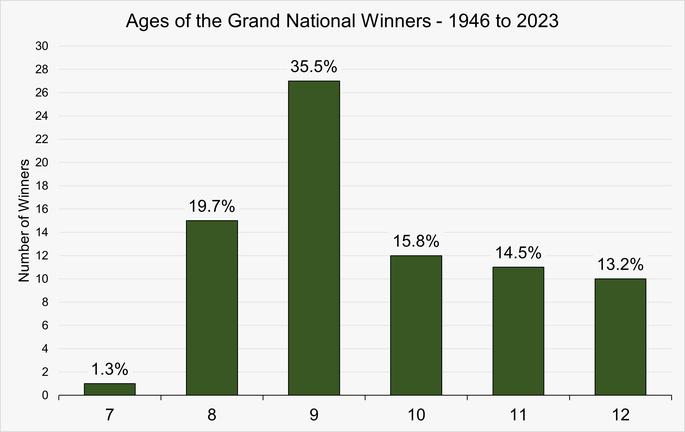
Again, this shows that more nine-year-olds have won the race than horses of any other age, with 35.5% of all race winners being aged nine.
Does Weight Carried Matter?
In addition to the age of the horses, the table of winners above also tells you how much weight the horses were asked to carry when they won the Grand National. This wasn’t just a random decision, instead drawing attention to the importance of weight when it comes to a horse’s chance of winning. We can breakdown the weight even further, looking at the average weight for each age group of winners:
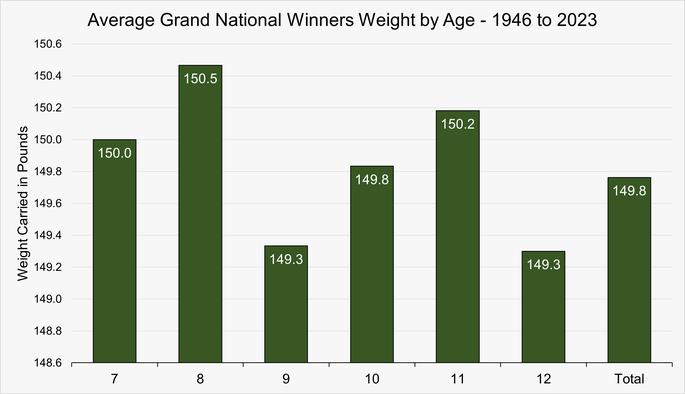
This chart shows us that on average, eight year old winners have carried a heavier weight to victory when compared to other ages, 1.2 pounds higher than the average nine year old winner. The average weight carried by all winners since World War II is just under 10 stone and 10 pounds (149.8lbs). The average weight carried drops down for the nine year olds, peaking again at age 11 before falling at age 12.
That means that if there’s a twelve-year-old you like the look of but you see that he’s being asked to carry more ten stone and 10 pounds, for example, then it’s worth taking a moment to consider whether that’s more weight than an twelve-year-old could reasonably be expected to perform well whilst carrying. We know what the average weight carried by a winning horse has been, but it is worth remembering that there is a lot of variance between the weights carried. The difficulty is knowing what weight is too much for an individual horse.
Ultimately, how much weight a horse carries is a crucial factor in the Grand National, with successful horses typically being stronger and therefore more able to perform well when carrying excess weight. If the horse that you’re hoping to bet on is being asked to carry a weight that seems excessive then it’s always worth having a look at their form. Have they carried that much before? If so, how did they get on when doing so?
It is interesting to note that the average amount of weight carried by winners seems to decrease after the age of 11. This is suggestive of the idea that the handicappers are under-valuing a horse’s ability as they age, meaning that it’s possible that you might be able to take advantage of that. also, if you see a nine-year-old that is carrying less than ten stone and ten pounds and is in good form, they might just be worth a look.
